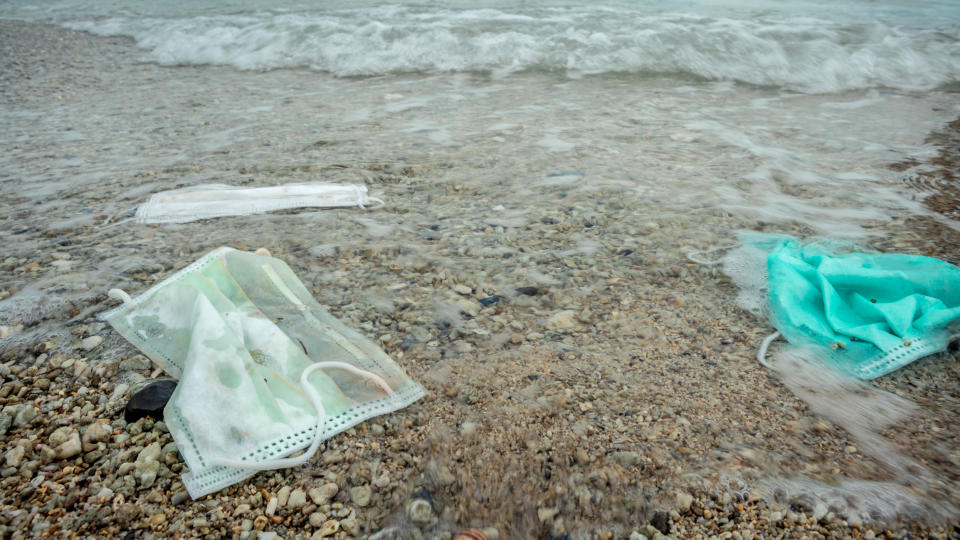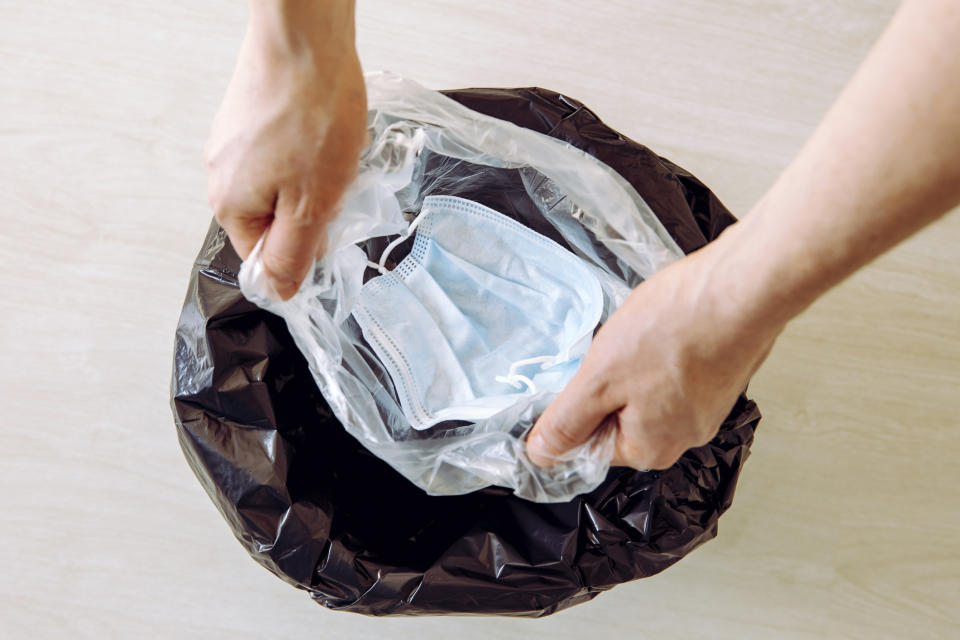How to safely dispose of a face mask

Who would have guessed a face mask would be 2020’s most important accessory?
But important they are, and they’re about to become even more so.
The British government has just announced that people will be required to wear face coverings in shops.
While they have also been compulsory on public transport since 15 June, from 24 July those over the age of 11 in England will need to wear a face covering in a shop, or risk facing a £100 fine.
Of course these new measures are designed to help protect us from the spread of coronavirus, but the surge in the use of face masks does have a downside in terms of an increase in the amount of single-use plastic waste we are generating as a result.
According to some estimates we are using 129 billion face masks across the globe every single month.
And while this uptick in mask use could be good news in terms of slowing the spread of COVID-19, environmentally the impact is not so positive with reports of dropped and discarded face masks becoming a common sight on pavements throughout the UK.
Read more: UK's first face mask vending machines launch
One waterways charity is so concerned about the impact it has issued a stark warning that personal protective equipment (PPE) is adding to Britain’s already extensive litter problem.
Thames21 believes the huge increase in the use of single-use plastic gloves and masks being used by non-healthcare professionals could negatively impact the environment.
Meanwhile University College London (UCL) estimates that if every person in the UK used one single-use mask each day for a year, we would create 66,000 tons of contaminated plastic waste.
UCL has already released a policy document that sets out the environmental implications of single-use face masks.
But on top of the environmental cost of throwing away disposable face masks, users should be considering if they are getting rid of it safely, to protect anyone else from the potential risk an infected mask might present.

So how do we dispose of masks safely?
In April the government issued guidance on disposing of Covid-waste, suggested that anyone with the virus or showing symptoms should dispose of their household waste in a rubbish bag placed into a second rubbish bag.
The outside bag should be securely tied and then kept separate from other people’s waste.
But if you are not showing signs or symptoms and simply need to safely dispose of your face covering the government says you should dispose of them in your ‘black bag’ waste bin at home or at work, or a litter bin if you’re outside.
“Do not put them in a recycling bin as they cannot be recycled through conventional recycling facilities,” the guidance states.
“Take them home with you if there is no litter bin - do not drop them as litter.”
The advice also points out that you do not need to put them in an extra bag or store them for a time before throwing them away.
Read more: What to do if a loved one refuses to wear a face mask
For masks specifically the World Health Organisation (WHO) suggests discarding face masks as soon as they feel damp in a closed bin. They then suggest washing hands with alcohol-based hand rub or soap and water.
London.gov has also provided some guidance about the wearing of face masks, including how to dispose of them safely.
“If you are using a single-use face covering, please ensure you dispose of it safely in your black bag rubbish at home if possible,” the guidance states.
“Never litter your face covering or gloves. This puts other people at risk, especially refuse collectors and street cleaners.”
Read more: The face mask hacks you need to know: From the best materials to how to make them fit
Disposing of single-use masks
According to James Milnes, Managing Director at sanitiser brand Zoono you should throw away disposable face masks after every use or straight away if it becomes damp.
“Wash your hands before touching the mask and remove it by loosening the straps behind the ears or head,” he suggests.
“Do not touch the front of the mask as this may be contaminated. Place the mask in the bin and immediately wash your hands again or use an antibacterial hand sanitiser to ensure bacteria hasn’t been transferred back onto your skin.”
As per government guidance masks should be placed in a closed bin and in general waste, rather than in the recycling.
“If you feel unwell with coronavirus symptoms, store your mask in a plastic rubbish bin bag and then place that bag into a second rubbish bag,” Milnes continues.
“Tie it securely and then keep it separate from all other waste. Wait for 72 hours before putting it in communal or external bins.”

Why is the wearing Face coverings so important?
Dr Ann Donnelly, a GP, with experience in Occupational Health and Holistic Healing believes the wearing of face coverings is an important aspect of the fight to stem the spread of coronavirus.
"As we reemerge post lockdown, we still have a duty of care to one another,” she explains.
"While we have no vaccine or definitive treatment for COVID-19, prevention remains our most effective weapon and face masks our best armour.
“Masks prevent virus spread through droplets produced when we talk, cough or sneeze. Considering that many people display no symptoms while infected masks remain an important means of defence against spread.”
How to care for your face mask
Dr Donnelly has put together some tips on how to effectively look after your face mask:-
1. Wash/sanitise your hands before and after putting on or removing your mask.
2. Do not touch the mask while wearing it. If adjustment is required wash/sanitise your hands after adjusting and indeed before adjusting where possible.
3. Replace the mask when damp and do not reuse single-use masks.
4. When removing your mask always do so from behind. Avoid touching the front of the mask.
5. Unhook elastic bands from behind the ears or untie the ties starting with the bottom one first and touch only these areas when putting into a peddle operated sealed bin. This is called a no-touch technique.
6. Reusable masks are best put in the wash immediately. Have more than one so you have at least one spare while you wash the other. This protects the environment from the waste of single use masks and preserves supplies for health care professionals.
7. Do not share masks especially after being worn.
8. Remember there are still members of our population who remain seriously vulnerable should they get COVID-19. Do your part to protect each other. We remain all in this together.


